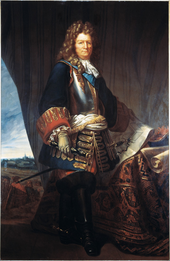Siege of Namur (1692)
Namur, sitting on the confluence of the Meuse and Sambre rivers, was a considerable fortress, and was a significant political and military asset.
As in 1691, five large armies were created for the five major fronts of the war: Flanders, the Moselle, the Rhine, Piedmont, and Roussillon.
[7] To deter William from marching to the town's relief, Louis arranged for a simultaneous landing in England to assist King James II in his attempt to regain his throne.
The actual town of Namur sat on low flat land on the north bank of the Sambre that was dominated by heights on all sides.
However, by reason of the position of its citadel (a complex of fortifications occupying the height on the south bank between the confluence of the Sambre and Meuse), it was one of the strongest frontiers in Flanders.
[12] The garrison managed a small sortie to reinforce a battery covering the main town, but it met with limited success.
In his memoirs, Jean Martin de la Colonie, a participant of the siege wrote, "It was through ignorance of the true state of the fortifications that these articles were agreed to, as it is only from the town side that the fortress could be taken, the rest being almost impregnable".
Coehoorn replied that his real consolation was in the fact that he had forced his great rival to move his siege batteries seven times during the assault.
[14] The heavy rain had made the roads become virtually impassable, which greatly restricted the supply of ammunition to the French gun batteries.
[15] However, the surrounding country, much of it woodland, provided so little forage that the French were forced to feed their animals on leaves and branches, which resulted in many losses.
Defeat at the Battle of La Hogue in early June had denied the French naval superiority in the English Channel, thus ending any hopes of a landing.
The issue was not completely decisive, and both sides could claim a victory of sorts, but William left the field in French hands, thus ending the Allied threat to Namur.



